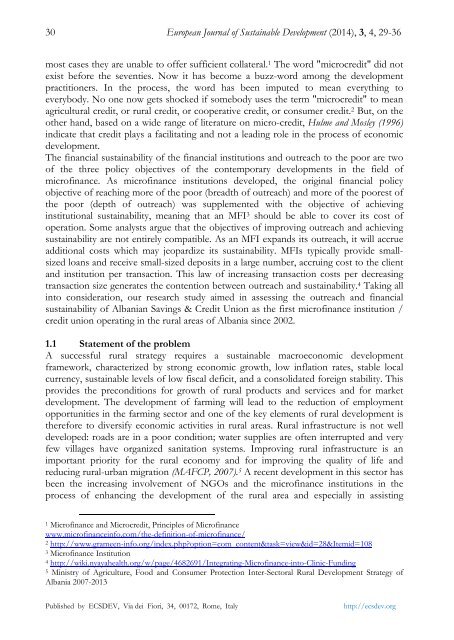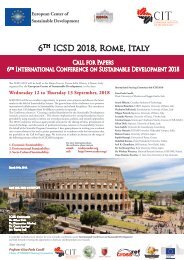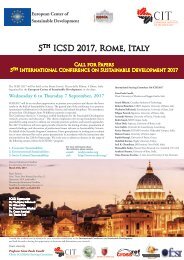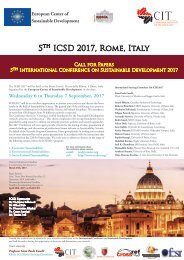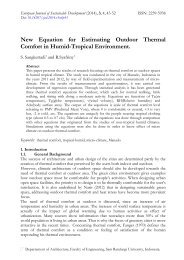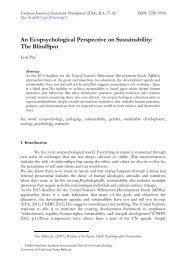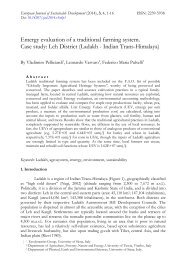Cooperative Microfinance in Agriculture Analyzing the Outreach and Financial Sustainability of Albanian Savings & Credit Union
Our research aimed in analyzing the outreach and financial sustainability of Albanian Savings & Credit Union. It was based on a descriptive study and on quantitative data that was collected through interviews, direct observations and different annual financial statements. Concerning the outreach, our study found out that the number of active clients increased from 7,621 active clients in 2003 to 15,499 active clients in 2012. The average loan size showed a growth for the period 2003-2008 by reaching the amount of $US 2,509, then it decreased at $US 2,207 in 2010 and raised at $US 2,314 in 2012. From the other hand, the Operating Expense Ratio has shown instability such as from 9.62% in 2002 it dropped to 8.62% in 2007 to fell off to 7.58% in 2009 and raised again in 2010 by 8.20%, while the cost per loan increased by making the ASC Union inefficient. Moreover, the dependency ratio reduced from 89% in 2005 to 26.8% in 2012 while retained earnings to total capital ratio went up to 9.2% in 2008, but then it reduced to 6% in 2012. Similarly to the dependency ratio, the donated capital has also shown reduction over the years from 45% in 2005 to 9.2% in 2012, allowing the ASC Union to be financially self-sufficient. Key words: Microfinance, Microcredit, Outreach, Financial Sustainability, Credit Union, Albania
Our research aimed in analyzing the outreach and financial sustainability of Albanian Savings & Credit Union. It was based on a descriptive study and on quantitative data that
was collected through interviews, direct observations and different annual financial statements. Concerning the outreach, our study found out that the number of active clients increased from 7,621 active clients in 2003 to 15,499 active clients in 2012. The average loan size showed a growth for the period 2003-2008 by reaching the amount of $US 2,509, then it decreased at $US 2,207 in 2010 and raised at $US 2,314 in 2012. From the other hand, the
Operating Expense Ratio has shown instability such as from 9.62% in 2002 it dropped to 8.62% in 2007 to fell off to 7.58% in 2009 and raised again in 2010 by 8.20%, while the
cost per loan increased by making the ASC Union inefficient.
Moreover, the dependency ratio reduced from 89% in 2005 to 26.8% in 2012 while retained earnings to total capital ratio went up to 9.2% in 2008, but then it reduced to 6%
in 2012. Similarly to the dependency ratio, the donated capital has also shown reduction over the years from 45% in 2005 to 9.2% in 2012, allowing the ASC Union to be
financially self-sufficient.
Key words: Microfinance, Microcredit, Outreach, Financial Sustainability, Credit Union,
Albania
Create successful ePaper yourself
Turn your PDF publications into a flip-book with our unique Google optimized e-Paper software.
30 European Journal <strong>of</strong> Susta<strong>in</strong>able Development (2014), 3, 4, 29-36<br />
most cases <strong>the</strong>y are unable to <strong>of</strong>fer sufficient collateral. 1 The word "microcredit" did not<br />
exist before <strong>the</strong> seventies. Now it has become a buzz-word among <strong>the</strong> development<br />
practitioners. In <strong>the</strong> process, <strong>the</strong> word has been imputed to mean everyth<strong>in</strong>g to<br />
everybody. No one now gets shocked if somebody uses <strong>the</strong> term "microcredit" to mean<br />
agricultural credit, or rural credit, or cooperative credit, or consumer credit. 2 But, on <strong>the</strong><br />
o<strong>the</strong>r h<strong>and</strong>, based on a wide range <strong>of</strong> literature on micro-credit, Hulme <strong>and</strong> Mosley (1996)<br />
<strong>in</strong>dicate that credit plays a facilitat<strong>in</strong>g <strong>and</strong> not a lead<strong>in</strong>g role <strong>in</strong> <strong>the</strong> process <strong>of</strong> economic<br />
development.<br />
The f<strong>in</strong>ancial susta<strong>in</strong>ability <strong>of</strong> <strong>the</strong> f<strong>in</strong>ancial <strong>in</strong>stitutions <strong>and</strong> outreach to <strong>the</strong> poor are two<br />
<strong>of</strong> <strong>the</strong> three policy objectives <strong>of</strong> <strong>the</strong> contemporary developments <strong>in</strong> <strong>the</strong> field <strong>of</strong><br />
micr<strong>of</strong><strong>in</strong>ance. As micr<strong>of</strong><strong>in</strong>ance <strong>in</strong>stitutions developed, <strong>the</strong> orig<strong>in</strong>al f<strong>in</strong>ancial policy<br />
objective <strong>of</strong> reach<strong>in</strong>g more <strong>of</strong> <strong>the</strong> poor (breadth <strong>of</strong> outreach) <strong>and</strong> more <strong>of</strong> <strong>the</strong> poorest <strong>of</strong><br />
<strong>the</strong> poor (depth <strong>of</strong> outreach) was supplemented with <strong>the</strong> objective <strong>of</strong> achiev<strong>in</strong>g<br />
<strong>in</strong>stitutional susta<strong>in</strong>ability, mean<strong>in</strong>g that an MFI 3 should be able to cover its cost <strong>of</strong><br />
operation. Some analysts argue that <strong>the</strong> objectives <strong>of</strong> improv<strong>in</strong>g outreach <strong>and</strong> achiev<strong>in</strong>g<br />
susta<strong>in</strong>ability are not entirely compatible. As an MFI exp<strong>and</strong>s its outreach, it will accrue<br />
additional costs which may jeopardize its susta<strong>in</strong>ability. MFIs typically provide smallsized<br />
loans <strong>and</strong> receive small-sized deposits <strong>in</strong> a large number, accru<strong>in</strong>g cost to <strong>the</strong> client<br />
<strong>and</strong> <strong>in</strong>stitution per transaction. This law <strong>of</strong> <strong>in</strong>creas<strong>in</strong>g transaction costs per decreas<strong>in</strong>g<br />
transaction size generates <strong>the</strong> contention between outreach <strong>and</strong> susta<strong>in</strong>ability. 4 Tak<strong>in</strong>g all<br />
<strong>in</strong>to consideration, our research study aimed <strong>in</strong> assess<strong>in</strong>g <strong>the</strong> outreach <strong>and</strong> f<strong>in</strong>ancial<br />
susta<strong>in</strong>ability <strong>of</strong> <strong>Albanian</strong> Sav<strong>in</strong>gs & <strong>Credit</strong> <strong>Union</strong> as <strong>the</strong> first micr<strong>of</strong><strong>in</strong>ance <strong>in</strong>stitution /<br />
credit union operat<strong>in</strong>g <strong>in</strong> <strong>the</strong> rural areas <strong>of</strong> Albania s<strong>in</strong>ce 2002.<br />
1.1 Statement <strong>of</strong> <strong>the</strong> problem<br />
A successful rural strategy requires a susta<strong>in</strong>able macroeconomic development<br />
framework, characterized by strong economic growth, low <strong>in</strong>flation rates, stable local<br />
currency, susta<strong>in</strong>able levels <strong>of</strong> low fiscal deficit, <strong>and</strong> a consolidated foreign stability. This<br />
provides <strong>the</strong> preconditions for growth <strong>of</strong> rural products <strong>and</strong> services <strong>and</strong> for market<br />
development. The development <strong>of</strong> farm<strong>in</strong>g will lead to <strong>the</strong> reduction <strong>of</strong> employment<br />
opportunities <strong>in</strong> <strong>the</strong> farm<strong>in</strong>g sector <strong>and</strong> one <strong>of</strong> <strong>the</strong> key elements <strong>of</strong> rural development is<br />
<strong>the</strong>refore to diversify economic activities <strong>in</strong> rural areas. Rural <strong>in</strong>frastructure is not well<br />
developed: roads are <strong>in</strong> a poor condition; water supplies are <strong>of</strong>ten <strong>in</strong>terrupted <strong>and</strong> very<br />
few villages have organized sanitation systems. Improv<strong>in</strong>g rural <strong>in</strong>frastructure is an<br />
important priority for <strong>the</strong> rural economy <strong>and</strong> for improv<strong>in</strong>g <strong>the</strong> quality <strong>of</strong> life <strong>and</strong><br />
reduc<strong>in</strong>g rural-urban migration (MAFCP, 2007). 5 A recent development <strong>in</strong> this sector has<br />
been <strong>the</strong> <strong>in</strong>creas<strong>in</strong>g <strong>in</strong>volvement <strong>of</strong> NGOs <strong>and</strong> <strong>the</strong> micr<strong>of</strong><strong>in</strong>ance <strong>in</strong>stitutions <strong>in</strong> <strong>the</strong><br />
process <strong>of</strong> enhanc<strong>in</strong>g <strong>the</strong> development <strong>of</strong> <strong>the</strong> rural area <strong>and</strong> especially <strong>in</strong> assist<strong>in</strong>g<br />
1 <strong>Micr<strong>of</strong><strong>in</strong>ance</strong> <strong>and</strong> Microcredit, Pr<strong>in</strong>ciples <strong>of</strong> <strong>Micr<strong>of</strong><strong>in</strong>ance</strong><br />
www.micr<strong>of</strong><strong>in</strong>ance<strong>in</strong>fo.com/<strong>the</strong>-def<strong>in</strong>ition-<strong>of</strong>-micr<strong>of</strong><strong>in</strong>ance/<br />
2 http://www.grameen-<strong>in</strong>fo.org/<strong>in</strong>dex.phpoption=com_content&task=view&id=28&Itemid=108<br />
3 <strong>Micr<strong>of</strong><strong>in</strong>ance</strong> Institution<br />
4 http://wiki.nyayahealth.org/w/page/4682691/Integrat<strong>in</strong>g-<strong>Micr<strong>of</strong><strong>in</strong>ance</strong>-<strong>in</strong>to-Cl<strong>in</strong>ic-Fund<strong>in</strong>g<br />
5 M<strong>in</strong>istry <strong>of</strong> <strong>Agriculture</strong>, Food <strong>and</strong> Consumer Protection Inter-Sectoral Rural Development Strategy <strong>of</strong><br />
Albania 2007-2013<br />
Published by ECSDEV, Via dei Fiori, 34, 00172, Rome, Italy<br />
http://ecsdev.org


